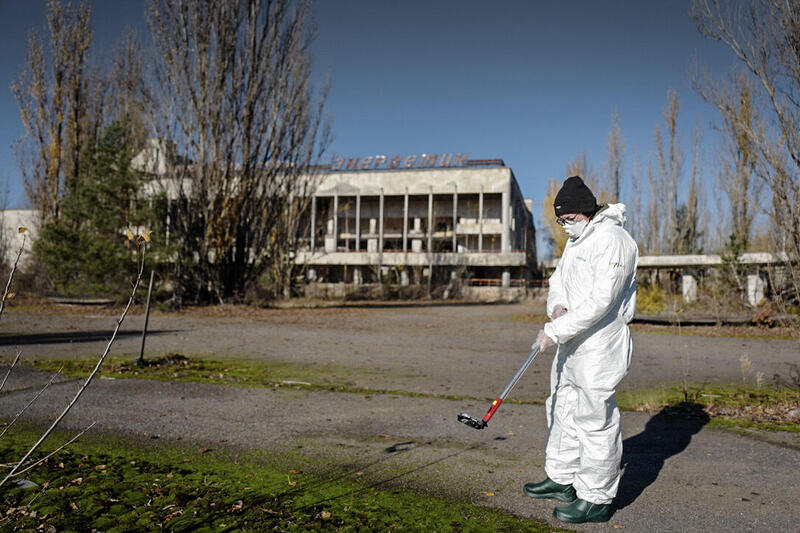Monitoring radiation and the situation around Zaporizhzhia NPP
Since the Russian occupation of the Zaporizhzhia NPP, Greenpeace has been at the forefront of independent investigations about the safety and security hazards that Russia’s illegal attack and occupation of Ukraine’s largest nuclear power plant has been causing. In addition, we are also campaigning for sanctions against Rosatom.


Problem
As Russians occupied Zaporizhzhia nuclear power plant, they started violating safety and security protocols. In addition, the prospect of deliberate radioactive contamination also increased following the destruction of the Nova Kakhovka dam in June 2023. The emergency response and safety management procedures are no longer functioning. The International Atomic Energy Agency (IAEA) inspectors on site provide very limited information. The threat of further destructive actions and environmental war crimes by Russian forces, coupled with the ever-present risk of electricity supply loss, places the entire region, as well as the whole Ukraine and potentially neighboring countries, at risk.
Our work
In response to the risk of a major catastrophic contamination from Ukrainian nuclear power plants, in partnership with environmental group SaveDnipro, Greenpeace deployed multiple radiation sensors to monitor and provide vital information on radiation levels in the event of a severe radioactive release.
Greenpeace Central and Eastern Europe also urges immediate EU sanctions against Rosatom as the risk of a nuclear disaster increases due to the Russian war against Ukraine.

The radiation sensors installed by Greenpeace and SaveDnipro on schools, hospitals and nuclear sites in southern Ukraine, aim to provide early warnings of increasing gamma radiation in case another nuclear disaster happens in Ukraine. The sensors provide real-time radiation level data via an online map called SaveEcoBot. They have been strategically placed in Zaporizhzhia City, Yuzhnoukrainsk, Odesa, Tarutyne, Yuzhne, and Uman. They have been installed in agreement with regional Ukrainian authorities responsible for nuclear emergency planning.

Research and reports
Even before Russian armed forces attacked the Zaporizhzhia nuclear plant, Greenpeace analysis was published highlighting major risks from Russian occupation. Since March 2022 Greenpeace has published multiple assessments on the safety and security hazards at the Zaporizhzhia nuclear plant.
We worked together with former UK military intelligence analysts to investigate and expose Russian military operations at and near the nuclear plant.
We continue to challenge the International Atomic Energy Agency (IAEA) and demand it to report on the true scale of Russian violations of nuclear safety and security principles.
We demand sanctions against Rosatom. We exposed that the nuclear trade between Russia and its European partners, particularly France and Hungary, is still ongoing. After more than two years since Rosatom occupied the Zaporizhzhia nuclear plant, Rosatom, the Russian state owned nuclear corporation, still remains largely unpunished.
-

Unveiling the Potential of the Dnipro River on the Eve of International Dnipro River Day
On July 2, 2024, in Kremenchuk, Greenpeace Central and Eastern Europe and Ro3kvit Urban Coalition for Ukraine presented the Dnipro River Integrated Vision — an extensive study highlighting the Dnipro…
-

Greenpeace Study: Ukraine Needs a Solar Energy Marshall Plan
Berlin/Kyiv, June 8, 2024 – A new groundbreaking study reveals that it would be feasible and beneficial if Ukraine installs five times more solar energy capacity in the next three…
-

Truth Hounds: New report claims that the destruction of Kakhovka Dam is an environmental war crime
Kyiv, Ukraine – [6.06.2024] – On the first anniversary of the destruction of the Kakhovka Hydroelectric Power Plant (HPP), Truth Hounds (TH) and Project Expedite Justice (PEJ) are publishing a…
-

McKenzie Intelligence analysis published on Russian claims of drone attacks on ZNPP offers strong indications of staged false flag operation by Russia
Their preliminary assessment based on the limited publicly available imagery is that the drones are likely to have been launched close to the ZNPP and thus likely, but not conclusively, from within Russian occupied territory.
-

Greenpeace Study: Ukraine Can Meet Its Energy Needs Solely with Wind and Solar
A mere fraction of its suitable land area could meet the entire electricity demand of Ukraine through solar and onshore wind energy alone.
-

New satellite intelligence report shows Russia uses Zaporizhzhia nuclear plant in Ukraine as military cover
Greenpeace calls for review of IAEA mission at Zaporizhzhia after evidence of failure of Agency to report on Russian violations
-

How Framatome and Siemens support Russia
Greenpeace report: Continued nuclear deals of the two companies with state-owned Rosatom benefit Russian interests in Ukraine and other countries
-

Ukrainian old-growth forests destroyed for EU market – Greenpeace expedition
European companies are complicit in the destruction of old growth forests in the Ukrainian Carpathians, the timber from which is sold throughout the European Union. This is the shocking finding of a Greenpeace Central and Eastern Europe research and field trip to the Ukrainian old-growth forest…
-

Interactive map reveals severe hazards at Ukraine’s nuclear plants caused by Russian invasion
Amsterdam, Netherlands – The extent of the nuclear threat posed by Vladimir Putin’s illegal invasion of Ukraine is unprecedented, new Greenpeace International mapping and technical analysis shows. Created with data from the Institute for the Study of War and the Centre for Information Resilience among others…
